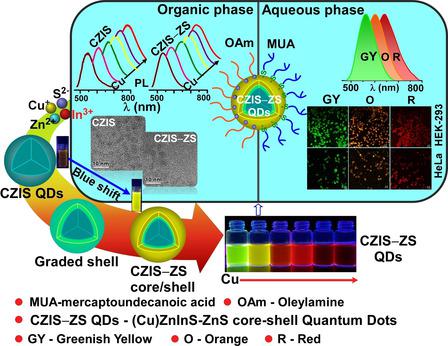当前位置:
X-MOL 学术
›
ChemistrySelect
›
论文详情
Our official English website, www.x-mol.net, welcomes your feedback! (Note: you will need to create a separate account there.)
Colloidal Gradated Alloyed (Cu)ZnInS/ZnS Core/Shell Nanocrystals with Tunable Optical Properties for Live Cell Optical Imaging
ChemistrySelect ( IF 2.1 ) Pub Date : 2018-06-04 , DOI: 10.1002/slct.201800742 Joicy Selvaraj 1 , Arun Mahesh 2 , Vaseeharan Baskaralingam 3 , Arunkumar Dhayalan 2 , Thangadurai Paramasivam 1
ChemistrySelect ( IF 2.1 ) Pub Date : 2018-06-04 , DOI: 10.1002/slct.201800742 Joicy Selvaraj 1 , Arun Mahesh 2 , Vaseeharan Baskaralingam 3 , Arunkumar Dhayalan 2 , Thangadurai Paramasivam 1
Affiliation

|
In this work, Cd‐free, oleophilic (Cu)ZnInS(core)−ZnS(shell) core/shell quantum dots (QDs) with varying Cu content in the core and shell thickness were synthesized by heating‐up method (core) followed by hot‐injection route (shell). Effect of Cu ion doping (in core) and shell growth on the structural and optical properties of (Cu)ZnInS−ZnS core/shell QDs is reported. Incorporation of Cu ions causes the crystalline phase transformation of zinc blende ZnInS ternary alloy to wurtzite Cu−Zn−In−S quaternary alloy. The (Cu)ZnInS alloyed core QDs are encapsulated with a wider bandgap ZnS shell with gradient interface. The photoluminescence of (Cu)ZnInS core QDs exhibits wide tunable multicolor emissions from green (535 nm) to deep red (683 nm) with large Stokes shift. After the growth of ZnS layer, the PL peak position and absorption edge undergo a hypsochromic shift with enhanced photoluminescence quantum yield up to 47.31%, which is due to the partial cation exchange of Cu+ and In3+ with Zn2+, yielding a graded core/shell structure with smooth potential interface. The radiative excited state lifetime is lengthened from 22.91 ns to 291.11 ns. The mercaptoundecanoic acid (MUA) functionalized QDs have been successfully used for in vitro fluorescence cellular imaging of HEK‐293 and HeLa cells. These QDs are cell permeable and suitable for visible light induced multicolor fluorescence‐based cellular imaging.
中文翻译:

具有可调节光学特性的胶体渐变合金化(Cu)ZnInS / ZnS核/壳纳米晶体,用于活细胞光学成像
在这项工作中,通过加热方法(核)合成了无镉,亲油的(Cu)ZnInS(核)-ZnS(壳)核/壳厚度不同的Cu /壳量子点(QDs),通过热注射途径(壳)。报道了铜离子掺杂(核中)和壳生长对(Cu)ZnInS-ZnS核/壳量子点的结构和光学性质的影响。Cu离子的掺入导致锌共混物ZnInS三元合金的结晶相转变为纤锌矿型Cu-Zn-In-S四元合金。(Cu)ZnInS合金质心量子点被具有带隙界面的带隙较宽的ZnS壳封装。(Cu)ZnInS核心量子点的光致发光显示出从绿色(535 nm)到深红色(683 nm)的宽可调多色发射,并具有较大的斯托克斯位移。ZnS层生长后,+和In 3+与Zn 2+,产生具有平滑电势界面的渐变核/壳结构。辐射激发态寿命从22.91 ns延长到291.11 ns。巯基十一烷酸(MUA)功能化的量子点已成功用于HEK-293和HeLa细胞的体外荧光细胞成像。这些量子点可渗透细胞,适用于可见光诱导的基于多色荧光的细胞成像。
更新日期:2018-06-04
中文翻译:

具有可调节光学特性的胶体渐变合金化(Cu)ZnInS / ZnS核/壳纳米晶体,用于活细胞光学成像
在这项工作中,通过加热方法(核)合成了无镉,亲油的(Cu)ZnInS(核)-ZnS(壳)核/壳厚度不同的Cu /壳量子点(QDs),通过热注射途径(壳)。报道了铜离子掺杂(核中)和壳生长对(Cu)ZnInS-ZnS核/壳量子点的结构和光学性质的影响。Cu离子的掺入导致锌共混物ZnInS三元合金的结晶相转变为纤锌矿型Cu-Zn-In-S四元合金。(Cu)ZnInS合金质心量子点被具有带隙界面的带隙较宽的ZnS壳封装。(Cu)ZnInS核心量子点的光致发光显示出从绿色(535 nm)到深红色(683 nm)的宽可调多色发射,并具有较大的斯托克斯位移。ZnS层生长后,+和In 3+与Zn 2+,产生具有平滑电势界面的渐变核/壳结构。辐射激发态寿命从22.91 ns延长到291.11 ns。巯基十一烷酸(MUA)功能化的量子点已成功用于HEK-293和HeLa细胞的体外荧光细胞成像。这些量子点可渗透细胞,适用于可见光诱导的基于多色荧光的细胞成像。


























 京公网安备 11010802027423号
京公网安备 11010802027423号